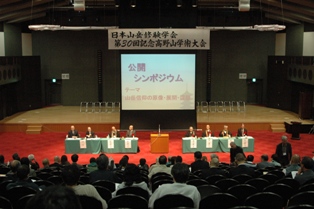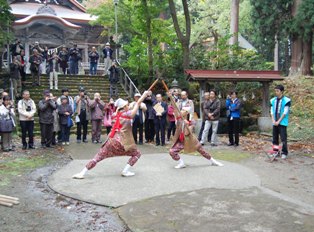|
Description of the Association
Annual Conference
Journals
Awards
Publications
Workshops & Symposiums
Exhibitions
News
Contact us
|
|
Description |
|
Bylaws |
|
Officers |
 |
Description of the Association for the Study of Japanese Mountain Religion
The purpose of the Association for the Study of Japanese Mountain Religion is to investigate and research from various points of view mountain religion as well as shugendō, both of which are the origin of the religious beliefs of the Japanese.
The association focuses on scholarly development while contributing socially.
Shugendō is the ascetic practices undertaken in the mountains, and the insight and power gained from them is the core of the religious activity.
Shugendō appeared in the middle of the Heian Period(794-1185) and these practitioners, who were called yamabushi and shugenja, have had up until the present day an enormous influence on Japanese festivals, rituals, performing arts, literature, fine arts, architecture and oral traditions.
The basis for the outlook on nature and cosmology held by the Japanese is found in shugendō.
Shugendō is a religion, which is a syncretic fusion of Buddhism, Shintoism, the Way of Yin and Yang as well as Taosim.
Although with the separation of Buddhism and Shintoism in the Meiji Period shugendō underwent a major change, it has been able to continue tenaciously up until now.
In 2004, having been highly judged worldwide as having cultural worth, the three sacred sites of Kumanosanzan, Kōyasan and Yoshino-Ōmine and the cultural landscape of the pilgrimage routes leading to them (Kumano Kodō, Kōyasan Chōishimichi and Ōmine Okugakemichi) were registered with UNESCO as the world heritage site, Sacred Sites and Pilgrimage Routes in the Kii Mountain Range.
This in turn has lead to stimulating a new development in the local regions.
This association had its beginnings in 1980 in the Nishi Nihon Sangaku Shugen Gakkai, which was founded by researchers in mountain religion and Shugendō of western Japan spearheaded by Enchō Tamura (Kyūshū University, Professor Emeritus) who was president at that time along with Toshimi Shigematsu (Kubote Museum, Former Chief Director) and Tadashi Nagano (Komazawa University, Former Professor).
In 1984, at the conference held at Hieizan, the association expanded its field of research beyond western Japan to cover all of Japan.
The association assumed its current name in 1994. The members number around 500 people.
The association is registered with the Science Council of Japan and is known not only within Japan, but outside of Japan as well, having not a few foreign members.
The members are varied, coming from universities all over Japan, research institutes, boards of education, museums, art museums, mountain religion and shugendō related shrines and temples as well as the general public.
The fields of research are also diverse, including history, geography, folklore, religion, literature, fine arts, performing arts and archaeology.
Counted among the association's members, there are also a number members who serve on the board of other academic research societies such as the Nihon Minzoku Gakkai (The Folklore Society of Japan), Jimbun Chiri Gakkai (The Human Geographical Society of Japan), Nihon Shūkyō Gakkai (The Japanese Association for Religious Studies), Nihon Bunka Jinrui Gakkai (The Japanese Society of Cultural Anthropology), Minzoku Geinō Gakkai (The Society of Folkloric Performing Arts), Chihōshi Kyōgikai and Nihon Indogaku Bukkyōgaku Gakkai (The Japanese Association of Indian and Buddhist Studies).
Furthermore, among the members, some have received prizes such the Chichibunomiya kinen gakujutsu shō and the Nihon Gakujutsu gakkai shō (Japan Society for the Promotion of Science Prize), both awarded by the Nihon Gakujutsu Shinkōkai (Japan Society for the Promotion of Science).
As for the association's international activity, at the 19th International Association for the History of Religions (IAHR) held in Japan in 2005, there were panel discussions on "Japanese Mountain Religion and Shugendō" and "Occult Japan: The Present State of the Ontake Belief", and in 2008 six members were invited to make presentations at the international conference held at Columbia University. on the research in Japanese religion, "Shugendō: The History and Culture of Japanese Religion".
Since many members of the association have made presentations at international conferences, research by association members has been receiving recognition both nationwide and worldwide.
The association's principal activities include yearly conferences held at such places as the sacred mountains of temples and shrines (the 30th conference was held last year) and the biannual publication of the journal, Sangaku Shugen (the last issue was the 44th), as well as presenting yearly both the Association for the Study of Japanese Mountain Religion award to those scholars showing outstanding achievement in research related to Japanese mountain religion and an award for a paper published in the association's journal by a young researcher in order to encourage research among young scholars.
In particular, at the yearly conference, there are lectures, a symposium and presentations by members, the contents of which are compiled in a special issue of Sangaku Shugen, as well as field trips to the shrines, temples and sacred mountains near the conference site.
What is more, there is a chance to view performing arts' performances and documents related to the sacred mountain, sacred places and remains found at the conference site.
This yearly conference is held with the backing of the temples and shrines of the sacred mountains, local governing bodies, and local museums.
Especially, the conferences of Nikkō, Kumano, Kōyasan and Yoshino were held at the same time as the registration of these places as world heritage sites.
In this way, the association is not only for the mutual scholarly pursuit of the members, but aims for social education and local advancement through the investigative research of Japanese mountain religion.
 |
a scene of annual conference symposium
(The 30th in Kōyasan) |
| |
|
 |
a scene of excursion in Sekiyama shrine
(The 29th in Myōkō) |
|
| |
|


